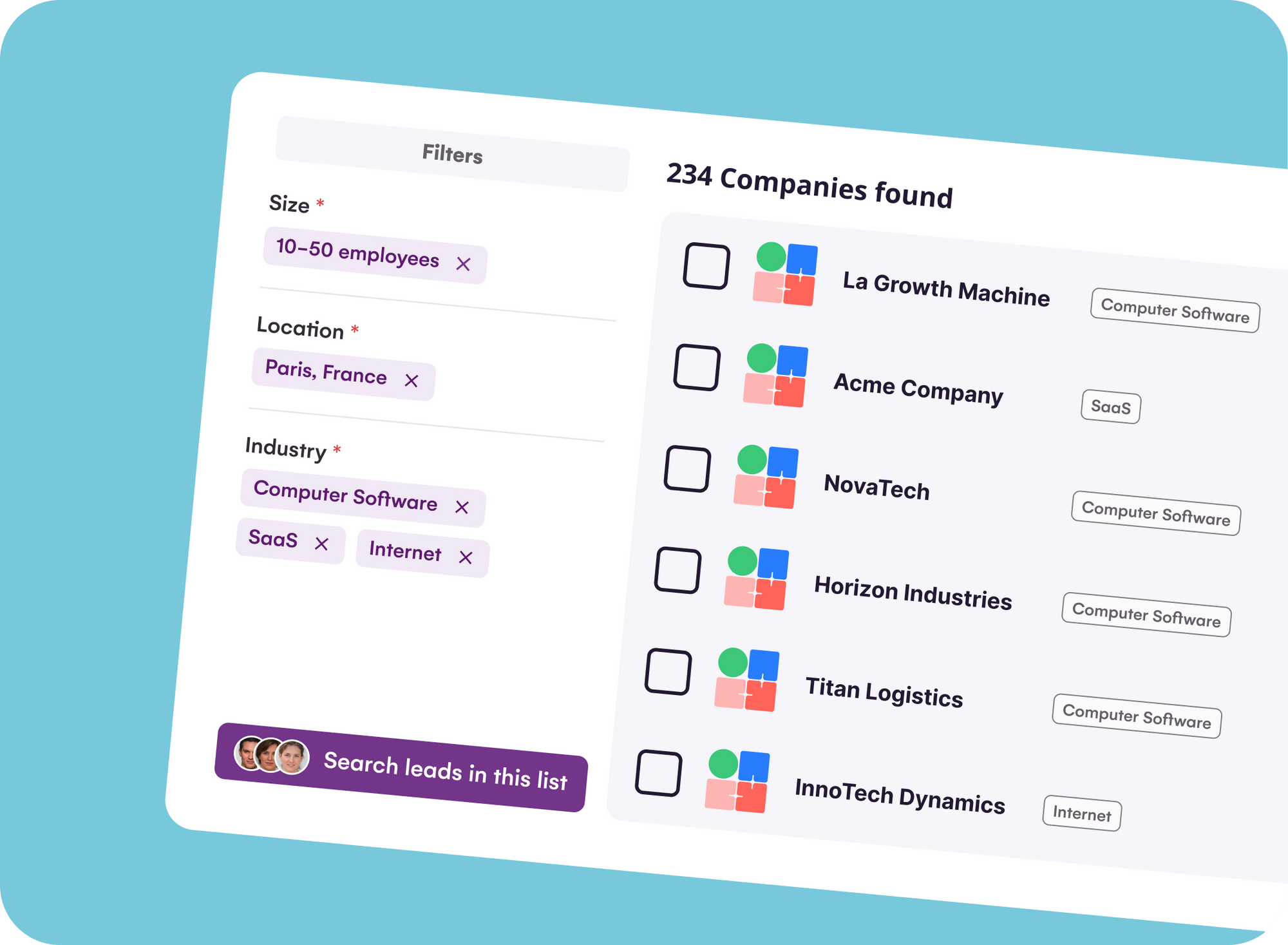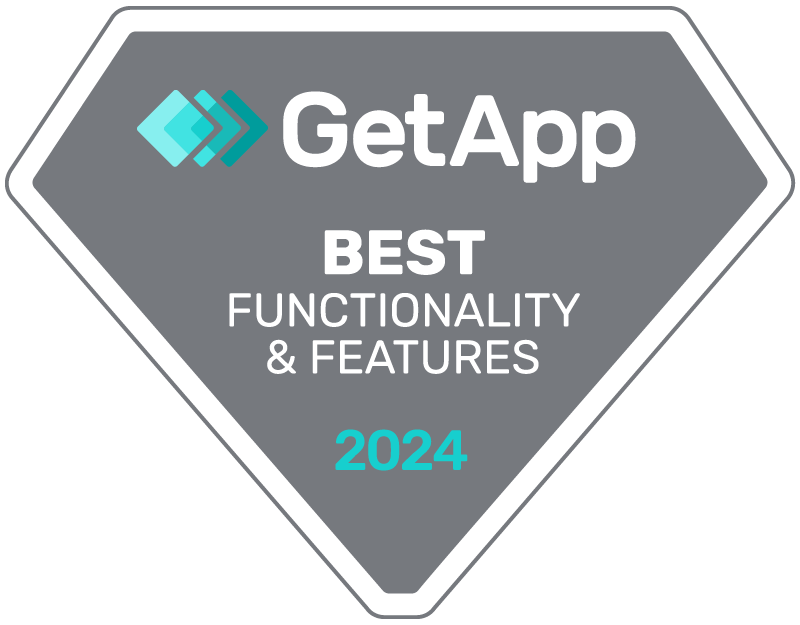TL;DR
Boost your B2B sales outreach with a quality lead database. Discover what makes a great database and how to leverage it for greater efficiency.
– Understand what a sales lead and B2B database are.
– Learn the benefits: generate qualified leads, target better, save time, and increase conversions.
– Key factors for choosing a database: needs, accuracy, freshness, integration, pricing, and compliance.
– Explore examples like ZoomInfo, UpLead, HubSpot, Apollo, Bookyourdata, and La Growth Machine.
– Implement best practices: define your ICP, verify data, use precise filters, and keep your database clean.
Maîtrise la prospection B2B avec La Growth Machine Trouve tes prospects, enrichis leurs données et contacte-les sur plusieurs canaux depuis une seule plateforme.
Découvrir La Growth MachineTable of contents
Looking for a reliable and accurate sales lead database to fuel your prospecting and outreach? You’re in the right place.
We’ll explain what makes a quality B2B sales lead database and why it’s essential for your outreach success. You’ll learn what a lead database is, the key factors for selecting the right database, and get best practices for maximizing your results.
What is a sales lead?
Let’s start with the basics — what exactly is a sales lead?
A sales lead is someone who sits at the very beginning of the sales funnel. They’re potential future customers who might benefit from your solution. This could be someone who’s already interacted with your company, or someone you’ve identified as a good fit, regardless of previous contact.
In sales, your role is to evaluate each lead’s interest level and qualify whether they match your ideal customer profile for your business.
The key to doing this successfully is having relevant information about these leads: their industry, what they do, who they serve, and so on. That’s where a sales lead database, also known as B2B database, becomes your best friend.
What is a B2B sales lead database?

A sales leads database is a collection of potential customers and their contact information. Basically, an organized list of people who might be interested in your solution.
You can include any information that helps your sales process run smoothly:
- Name
- Company
- Job title
- Phone number
- LinkedIn URL
- And more relevant data points
This database is what powers your outbound sales, where your team actively reaches out to potential customers instead of waiting for them to come to you.
A good sales lead database does more than store contact details, though. It also helps you find and connect with the right prospects, making your entire sales process more efficient.
The benefits of using a sales lead database
Using a sales lead database gives your business several key advantages that directly impact your bottom line.
Generate more qualified leads
A sales lead database helps build your sales pipeline by identifying prospects who genuinely need your solution. Rather than reaching out randomly, you’re connecting with companies and decision-makers who match your ideal customer profile. This means focusing your energy on conversations that have real potential.
Target the right people
You can filter your prospect list by specific criteria like industry, company size, and job title to reach decision-makers who matter. Your sales team connects with people who not only need your solution but also have the authority to move forward. No more wasted time on mismatched prospects.
Save time and money on prospecting
Instead of your team spending hours hunting down contact information, they get instant access to verified contact details. This means more time having meaningful conversations with prospects.
Increase your conversion rate
When you combine precise targeting with relevant messaging, prospects are more likely to engage. It’s simple: when you reach out to the right people with messages that resonate, you get more positive responses and book more meetings.
Close more deals faster
Quality lead information enables your team to have more informed conversations from the start. They understand who they’re talking to and can focus on solving real business challenges, moving deals forward naturally.
The end result? A more reliable sales process that consistently brings in new business.
Did you know? 💡
LGM Database helps you find your perfect prospects in one click. Filter companies by industry, size, and location to match your ideal customer profile, then identify the right decision-makers within those companies. All data is GDPR-compliant and always up-to-date, so you can focus on quality conversations that matter.
How to choose the right sales lead database

Picking the right sales lead database can make or break your outbound efforts. Here’s what to focus on when evaluating your options.
1. Start with your specific needs
Take a step back before diving into features. What industries are you targeting? Do you need contacts across different countries? Which data points drive your sales process? This clarity helps you avoid overpaying for unnecessary features.
2. Test data accuracy first
Most providers offer free trials – use them! Send test emails, make some calls, and verify job titles. Remember: a massive database of 10 million contacts won’t help if the information isn’t reliable.
3. Look for data freshness
Find out how frequently the provider updates their database. People change roles, companies evolve, and contact details become obsolete. Quality databases maintain fresh information and automatically clean out invalid data.
4. Check integration capabilities
Your database should work smoothly with your existing tools, whether that’s your CRM, email platform, or sales automation solution. Manual data transfers waste time and lead to mistakes.
5. Consider scalability and pricing
Think ahead about your growth. Compare pricing models: some charge per contact, others offer unlimited access. Factor in your team size and expected usage to find what makes sense for your budget.
6. Read the fine print on compliance
Make sure the provider follows data protection regulations like GDPR. You don’t want legal headaches from using improperly sourced contact information.
Sales lead databases examples
Here’s a look at some well-known sales lead databases and what they offer:
ZoomInfo
One of the largest B2B databases with over 300 million professional contacts and 150 million company profiles. Particularly useful for enterprise sales teams who need detailed company data, tech stack information, and buying intent signals. Their organizational charts and decision-maker mapping provide strong insights.
UpLead
Focuses on data quality with real-time email verification across their 160+ million contacts. Offers 50+ search filters and maintains a 95% data accuracy rate. A practical option for small to medium businesses who need reliable contact information at a reasonable cost.
HubSpot
Beyond its CRM foundation, HubSpot includes prospecting and lead management features. Works well for companies wanting an all-in-one solution that brings together lead database access, marketing automation, sales pipeline management, and customer service tools.
Apollo
A sales intelligence platform with 210+ million verified contacts. The platform includes email sequencing, call tracking, and sales analytics alongside its database. Teams appreciate its straightforward interface and connected approach to prospecting.
Bookyourdata
Bookyourdata takes a fresh approach to sales lead databases by offering ready-to-download, real-time verified B2B contact lists instead of locking users into heavy subscriptions. With a 97% accuracy guarantee and pay-as-you-go pricing, it’s designed for businesses that want flexibility without sacrificing quality.
La Growth Machine
La Growth Machine’s native LGM Database integrates lead discovery with multichannel outreach. Find prospects and launch personalized campaigns across LinkedIn, email, and X from one platform. Built to simplify the prospecting workflow from start to finish.

Each solution serves different needs and budgets. Choose based on your target market, team size, and sales process requirements.
Best practices for using a sales lead database
Getting the most from your sales lead database requires a strategic approach. Here are the essential practices that turn raw data into targeted outreach.
Define your ideal customer profile first
Before searching your database, map out exactly who you’re targeting. What industries do your best customers come from? What company sizes? Which job titles make buying decisions? A clear ideal customer profile prevents you from wasting time on leads that will never convert.
Verify and enrich your data regularly
Always verify email addresses and phone numbers before launching campaigns. Enrich basic contact details with additional information like recent company news, technology stack, or social media activity to personalize your messaging.
Use precise filtering for targeted lists
Don’t export thousands of contacts and hope for the best. Use specific filters to narrow your search to highly relevant prospects. Aim for smaller, targeted lists of 200-250 leads rather than massive spreadsheets. Group leads by industry, company size, role, or pain points so you can craft specific messages that resonate with each segment.
Keep your database clean and updated
Set up regular data hygiene routines. Remove bounced emails, update job changes, and delete unresponsive contacts. A smaller, clean database outperforms a large, messy one every time.
Track and measure your results
Monitor which sources provide the best leads, which filters generate higher response rates, and which segments convert most often. Use this data to refine your approach and focus on what actually works.
The goal is turning your database into a reliable pipeline generator, not just a contact storage system.
Conclusion
Sales lead databases are now a core part of B2B sales. They replace manual prospecting with reliable, current contact information. Your team can focus on what they do best: having meaningful conversations with prospects.
Success comes from choosing and using your database wisely. Start with a clear picture of your ideal customer, prioritize quality leads over sheer numbers, maintain clean data, and track your results. Used well, your database becomes the backbone of a consistent sales pipeline.
Whether you’re just starting to build your prospect list or looking to improve your existing outreach, the right database makes a real difference. Good data is an investment that pays off through better targeting, saved time, and more conversations that lead to deals.
Looking for a more efficient way to find and reach prospects?
La Growth Machine combines a lead database with data enrichment and multichannel outreach. Find relevant prospects, verify their contact details, and connect via LinkedIn, email, and Twitter from one platform.
✅ Verified B2B contacts
✅ Real-time data enrichment
✅ Multichannel outreach
✅ GDPR-compliant data











Comments